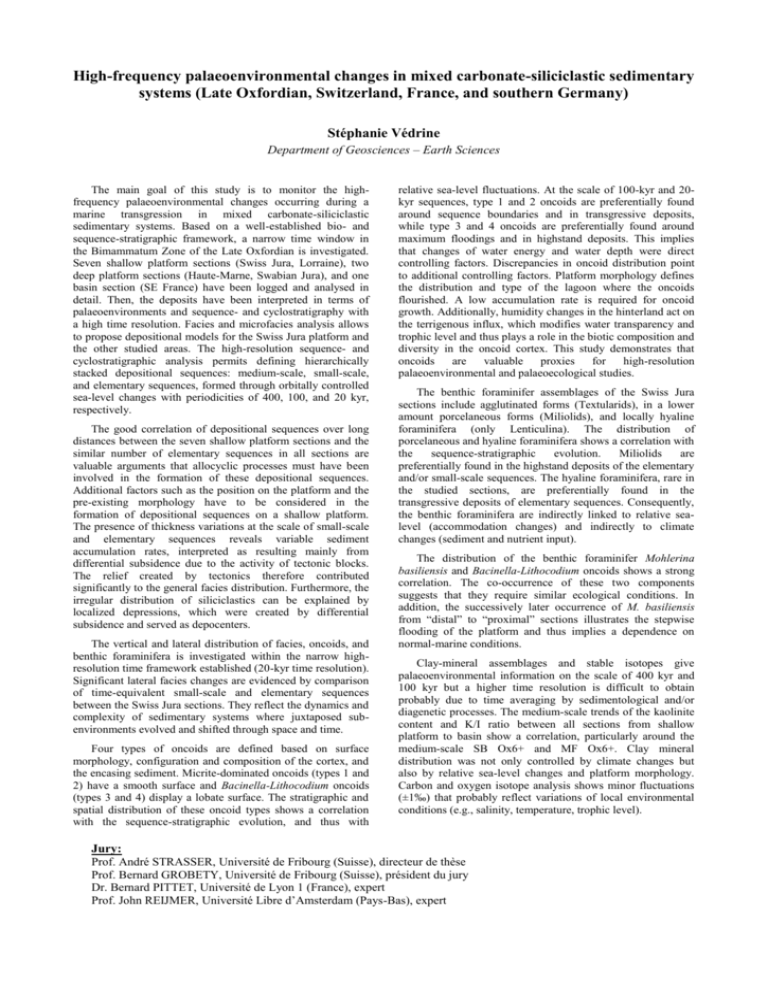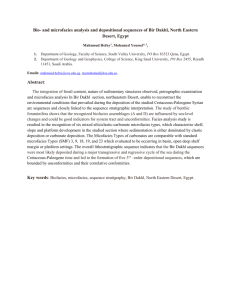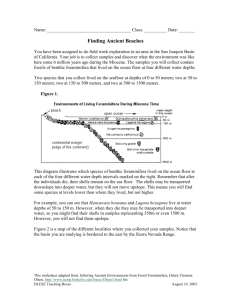High-frequency palaeoenvironmental changes in mixed carbonate
advertisement

High-frequency palaeoenvironmental changes in mixed carbonate-siliciclastic sedimentary systems (Late Oxfordian, Switzerland, France, and southern Germany) Stéphanie Védrine Department of Geosciences – Earth Sciences The main goal of this study is to monitor the highfrequency palaeoenvironmental changes occurring during a marine transgression in mixed carbonate-siliciclastic sedimentary systems. Based on a well-established bio- and sequence-stratigraphic framework, a narrow time window in the Bimammatum Zone of the Late Oxfordian is investigated. Seven shallow platform sections (Swiss Jura, Lorraine), two deep platform sections (Haute-Marne, Swabian Jura), and one basin section (SE France) have been logged and analysed in detail. Then, the deposits have been interpreted in terms of palaeoenvironments and sequence- and cyclostratigraphy with a high time resolution. Facies and microfacies analysis allows to propose depositional models for the Swiss Jura platform and the other studied areas. The high-resolution sequence- and cyclostratigraphic analysis permits defining hierarchically stacked depositional sequences: medium-scale, small-scale, and elementary sequences, formed through orbitally controlled sea-level changes with periodicities of 400, 100, and 20 kyr, respectively. The good correlation of depositional sequences over long distances between the seven shallow platform sections and the similar number of elementary sequences in all sections are valuable arguments that allocyclic processes must have been involved in the formation of these depositional sequences. Additional factors such as the position on the platform and the pre-existing morphology have to be considered in the formation of depositional sequences on a shallow platform. The presence of thickness variations at the scale of small-scale and elementary sequences reveals variable sediment accumulation rates, interpreted as resulting mainly from differential subsidence due to the activity of tectonic blocks. The relief created by tectonics therefore contributed significantly to the general facies distribution. Furthermore, the irregular distribution of siliciclastics can be explained by localized depressions, which were created by differential subsidence and served as depocenters. The vertical and lateral distribution of facies, oncoids, and benthic foraminifera is investigated within the narrow highresolution time framework established (20-kyr time resolution). Significant lateral facies changes are evidenced by comparison of time-equivalent small-scale and elementary sequences between the Swiss Jura sections. They reflect the dynamics and complexity of sedimentary systems where juxtaposed subenvironments evolved and shifted through space and time. Four types of oncoids are defined based on surface morphology, configuration and composition of the cortex, and the encasing sediment. Micrite-dominated oncoids (types 1 and 2) have a smooth surface and Bacinella-Lithocodium oncoids (types 3 and 4) display a lobate surface. The stratigraphic and spatial distribution of these oncoid types shows a correlation with the sequence-stratigraphic evolution, and thus with relative sea-level fluctuations. At the scale of 100-kyr and 20kyr sequences, type 1 and 2 oncoids are preferentially found around sequence boundaries and in transgressive deposits, while type 3 and 4 oncoids are preferentially found around maximum floodings and in highstand deposits. This implies that changes of water energy and water depth were direct controlling factors. Discrepancies in oncoid distribution point to additional controlling factors. Platform morphology defines the distribution and type of the lagoon where the oncoids flourished. A low accumulation rate is required for oncoid growth. Additionally, humidity changes in the hinterland act on the terrigenous influx, which modifies water transparency and trophic level and thus plays a role in the biotic composition and diversity in the oncoid cortex. This study demonstrates that oncoids are valuable proxies for high-resolution palaeoenvironmental and palaeoecological studies. The benthic foraminifer assemblages of the Swiss Jura sections include agglutinated forms (Textularids), in a lower amount porcelaneous forms (Miliolids), and locally hyaline foraminifera (only Lenticulina). The distribution of porcelaneous and hyaline foraminifera shows a correlation with the sequence-stratigraphic evolution. Miliolids are preferentially found in the highstand deposits of the elementary and/or small-scale sequences. The hyaline foraminifera, rare in the studied sections, are preferentially found in the transgressive deposits of elementary sequences. Consequently, the benthic foraminifera are indirectly linked to relative sealevel (accommodation changes) and indirectly to climate changes (sediment and nutrient input). The distribution of the benthic foraminifer Mohlerina basiliensis and Bacinella-Lithocodium oncoids shows a strong correlation. The co-occurrence of these two components suggests that they require similar ecological conditions. In addition, the successively later occurrence of M. basiliensis from “distal” to “proximal” sections illustrates the stepwise flooding of the platform and thus implies a dependence on normal-marine conditions. Clay-mineral assemblages and stable isotopes give palaeoenvironmental information on the scale of 400 kyr and 100 kyr but a higher time resolution is difficult to obtain probably due to time averaging by sedimentological and/or diagenetic processes. The medium-scale trends of the kaolinite content and K/I ratio between all sections from shallow platform to basin show a correlation, particularly around the medium-scale SB Ox6+ and MF Ox6+. Clay mineral distribution was not only controlled by climate changes but also by relative sea-level changes and platform morphology. Carbon and oxygen isotope analysis shows minor fluctuations (±1‰) that probably reflect variations of local environmental conditions (e.g., salinity, temperature, trophic level). Jury: Prof. André STRASSER, Université de Fribourg (Suisse), directeur de thèse Prof. Bernard GROBETY, Université de Fribourg (Suisse), président du jury Dr. Bernard PITTET, Université de Lyon 1 (France), expert Prof. John REIJMER, Université Libre d’Amsterdam (Pays-Bas), expert








